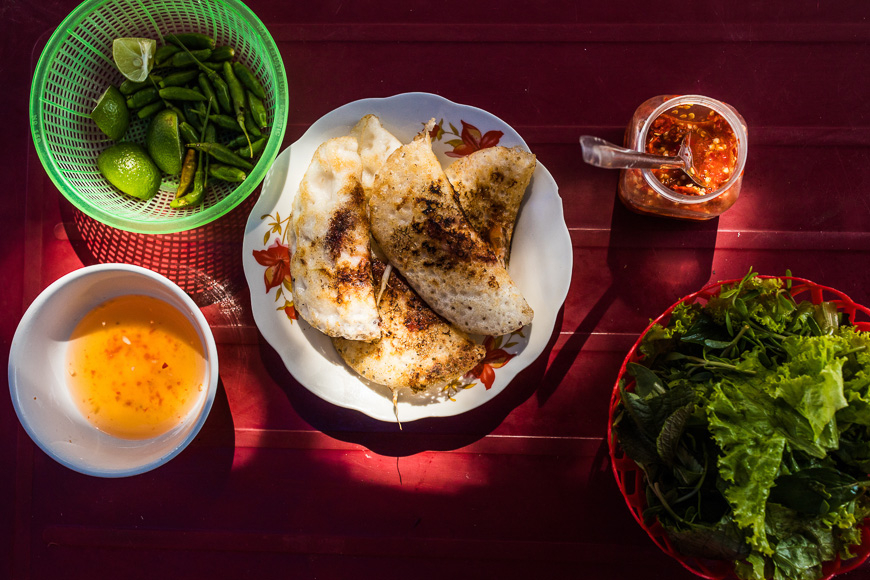Eat when the locals do
To find the best food in Vietnam, eat when the locals do. In other words: eat early. Everything gets curiously quiet after Vietnam’s mealtimes are over, and it can be hard to find a satisfying option. On the other hand, eating together with the locals is guaranteed fun each time.
Strike out just after sunrise for unforgettable bowls of piping hot noodles, hearty rice porridge, or sticky rice cakes dipped in peanuts. The areas near markets are prime spots for morning vendors who feed school children, market sellers, and locals heading to work.
Vietnam’s lunch stalls open for business from 11:30am to 1pm. Look for the ever-reliable cơm bình dân: A choose-it-yourself eatery with an array of family-style dishes — fluffy omelette, garlicky greens, caramelised fish and roasted pork — laid out for display and heaped on plates of hot rice. (So good!)
Come 5pm, Vietnam’s restaurants and stalls begin spreading their stools on the sidewalk for the dinner crowd. The hours between 6pm and 8pm are your sweet spot for flaming hotpots, grilled seafood and barbecue sessions in the balmy evening air. The busier the stall, the more likely it’s worth the wait.
Choose your stalls wisely

Vietnam boasts an ever-growing list of eateries that travellers know and love, such as Hoi An’s Banh Mi Phuong and The Lunch Lady in Ho Chi Minh City. But it’s well worth it to try new places when you travel. Just clocked an interesting stall down an alley? Use your eyes to check off this list:
1. Is the set up — tables, floors, utensils — clean and organised?
2. Are the ingredients or dishes nicely presented, colourful and farm-fresh?
3. Is there a gaggle of local customers eating or waiting to be served?
If the answers are ‘yes’, you’ve picked a good spot. Place an order and enjoy.
"TIP: In Vietnam, many stalls serve just two or three dishes perfected by the owner-chef. If you’re unsure what to order, don’t be afraid to request whatever the next table is having."
Brush up on Vietnamese street food etiquette
Vietnam’s unspoken customs for eating on the sidewalk are simple and forgiving, especially for newcomers. A rule you can always rely on is, ‘eat first, pay later.’ Place your order at the front, then choose your own table or stool to sit. A quick wipe down of your chopsticks or spoon before eating is perfectly normal (and even wise), as is using your chopsticks to sample any shared dishes on the table. Dirty napkins, squeezed limes or herb stems can be dropped into bins below as you eat. Once you’re finished, lay your chopsticks together on the top of your bowl.
For small stalls, diners usually ask the total and pay the chef directly on the way out. In some cases, a server may come to the table and do a mental tally of your bill. Trust them — they do this every day. A written tab is not common for local food, but you can ask for it if needed.
"TIP: At peak times, other diners may join you to eat at your table. In these cases, a smile is all the interaction that’s required."
Get savvy about condiments and sauces

Condiments are essential to the Vietnamese dining experience. On your table, there will often be a jar of light fish sauce, a jar of garlic and chili in vinegar, and perhaps a jam-like chili paste, freshly chopped chili, limes or kumquats, or even a pungent shrimp paste. All these are for you to customise the meal to your liking.
With noodle dishes, a side serving of herbs and leafy greens — mint, cilantro, basil and lettuce — comes free of charge. Fold these into the broth or toss with dry noodles for added crunch and aromatics. For rolls, a stack of rice paper and larger leaves for rolling and dipping is offered. Dipping sauces may range from tangy tamarind, to sweet-and-salty fish sauce to roasted peanut sauce. Your server will be happy to show you the right pairing.
TIP: Instead of soy sauce, the Vietnamese prefer a few drops of fish sauce to season their meals. There are countless grades and varieties of fish sauce, and it’s a staple of any kitchen.
Try some basic Vietnamese words
When your mouth isn’t full of delicious bites, you may want to express yourself using a few common Vietnamese phrases. Here are some every traveller should know:
Anywhere in Vietnam, a confident ‘em ơi!’ will bring a server to assist you.
Vegetarians in Vietnam will want to learn the words ‘không thịt’ (no meat) and ‘ăn chay’ (vegetarian food) to use during their travels.
‘Ngon quá’ means ‘very delicious’.
When pointing out your preferences, ask for ‘một suất’ (one serving), or ‘một cái này’ (one of these.)
‘Trà đá’ is iced green tea, which Vietnamese stalls all over the country serve instead of water. In cold weather you may like ‘trà nóng’ (hot tea) to go with your meals.
Ready to leave? Say ‘tính tiền’ to request the bill.
Happy eating!









